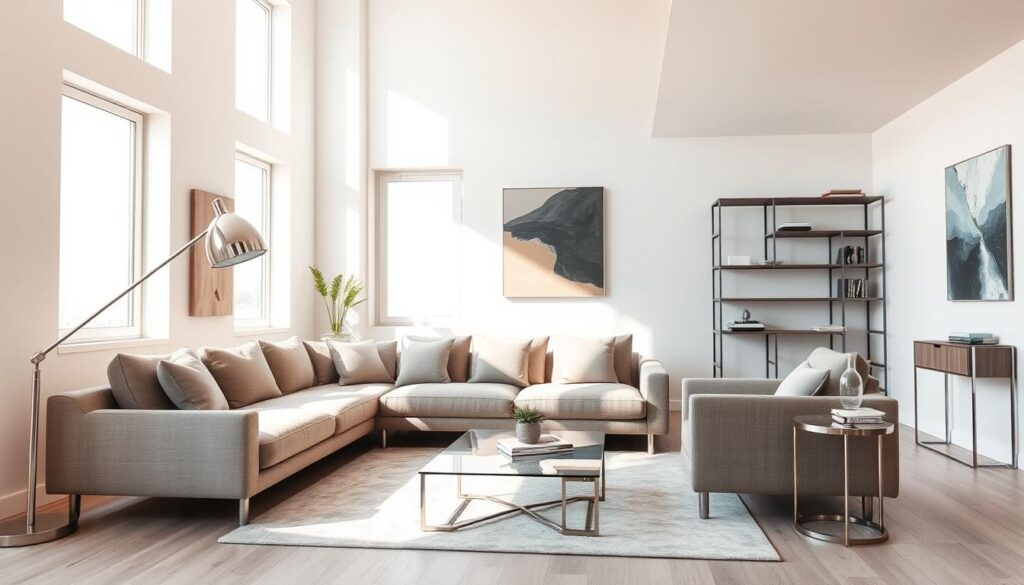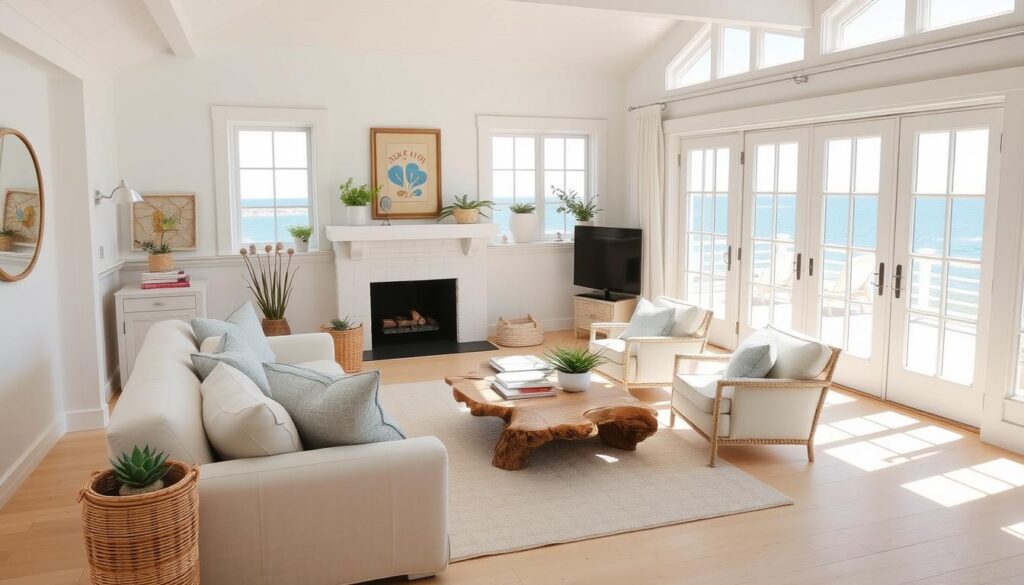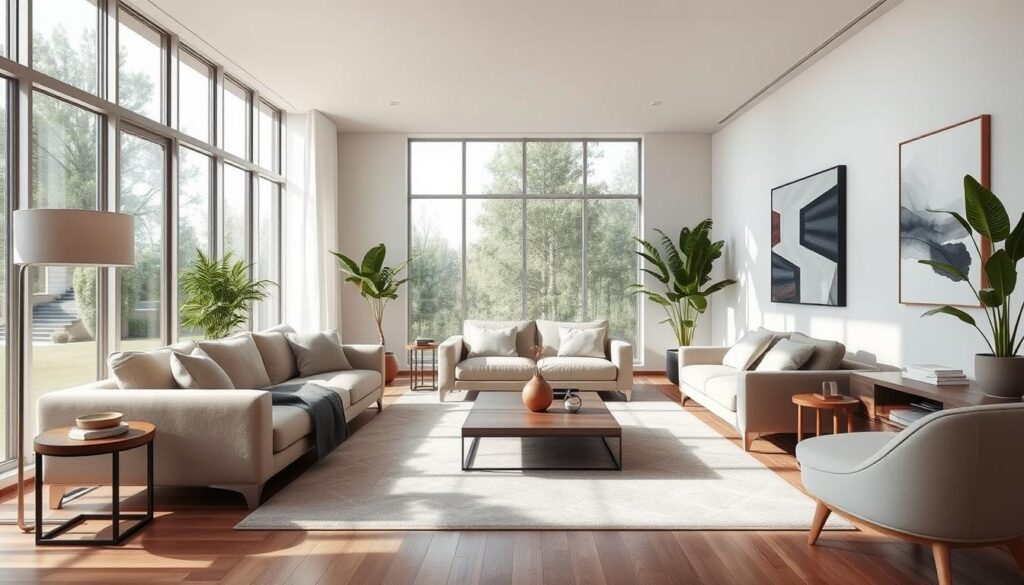The world of interior design is vast and varied. There are many popular interior design styles to choose from. A recent survey found that over 70% of homeowners see their living space as a reflection of their personality.
We will explore the most sought-after design styles with you. Our guide will help you find the perfect style for your home. We cover the key characteristics, advantages, and examples of each style. This ensures you understand your options well.
Choosing the right design style can be overwhelming. We make it easier by guiding you through various styles. From traditional to modern and contemporary, we cover it all.
Key Takeaways
- Understanding the different popular interior design styles is crucial for homeowners.
- Our guide covers the key characteristics and advantages of each style.
- We’ll help you identify the perfect style for your living space.
- From traditional to modern, we’ll explore the most sought-after styles.
- Our comprehensive guide ensures you have a thorough understanding of your options.
Understanding Home Interior Design Styles
Interior design styles are more than looks; they shape our home’s feel and use. Exploring interior design shows how styles change our living areas.
Definition and Importance of Interior Design
Interior design makes indoor spaces better and more beautiful. It meets the needs of those who use the space. Good interior design can lift our mood, make spaces work better, and even improve our health.
Interior design turns a house into a home. The right style shows who we are and meets our needs. Whether it’s modern with its simplicity or traditional with its classic touches, our choice sets the mood of our home.
How Styles Influence Mood and Functionality
The style of our home affects our mood and how well it works. For example:
- Modern styles bring calm with their simple look.
- Traditional styles make a space feel cozy and inviting.
- Eclectic styles let us show our unique taste, making our home interesting.
Function matters too. A well-planned kitchen makes cooking and hosting fun. A well-designed living room becomes the center of family and friend gatherings.
In short, knowing about interior design styles is key to a beautiful and useful home. Thinking about how styles affect mood and function helps us choose wisely, improving our life at home.
Classic Interior Design Styles
The world of interior design is filled with classic styles that have lasted for ages. These designs bring a sense of tradition and comfort to our homes. They are not just pretty but also carry a rich heritage.
Overview of Traditional and Transitional Designs
Classic interior design includes traditional and transitional styles. Traditional design uses ornate details, rich colors, and classic furniture. It makes spaces warm and welcoming. Transitional design mixes traditional and modern elements for a balanced look.
Transitional design is a mix between old and new. It offers a style that can fit many tastes. It combines the beauty of traditional design with the simplicity of modern elements, making spaces unique and engaging.
Key Characteristics of Classic Styles
Classic interior design styles, like traditional and transitional, share key traits. These traits make them appealing for years. They include:
- A focus on quality craftsmanship and materials
- The use of rich, muted color palettes
- Incorporation of classic furniture pieces and ornate details
- A blend of traditional elements with modern touches in transitional designs
| Design Element | Traditional Design | Transitional Design |
|---|---|---|
| Furniture | Ornate, classic pieces | Simple, clean lines with some ornate details |
| Color Palette | Rich, bold colors | Mixed rich and neutral tones |
| Decor | Extensive use of patterns and textures | Balanced use of patterns, textures, and minimal decor |
Knowing these traits helps homeowners and designers create beautiful, timeless spaces. These spaces reflect a lasting elegance.
Modern Interior Design Styles
Modern interior design focuses on simplicity and function. It aims to create a sleek, contemporary look. This style uses clean lines, minimal decor, and puts functionality first.
Exploring Minimalism and Industrial Design
Minimalism and industrial design are big in modern styles. Minimalist interior design styles are all about simplicity. They use a few colors and little decoration to bring calm and clarity.
Industrial design, by contrast, uses exposed brick, metal, and reclaimed wood. It gives a rugged, urban feel.
- Minimalism emphasizes simplicity and clean lines.
- Industrial design incorporates rugged, urban elements.
- Both styles prioritize functionality and minimal decor.
Essential Elements of Modern Aesthetics
What makes modern aesthetics stand out? Modern design often includes:
- Clean lines and minimal decoration.
- A simple color scheme, like white, black, and gray.
- Furniture and decor that serve more than one purpose.
To learn more about interior design styles, including modern and minimalist, check out https://www.decorilla.com/online-decorating/interior-design-styles-101/. It’s a detailed guide.
Eclectic and Bohemian Interior Design
The eclectic and bohemian styles celebrate creativity. They let homeowners mix different elements to make a space that’s truly their own. These styles are great for those who want to show their unique personality in their home.
Defining Eclectic Style: Embracing Diversity
Eclectic style is all about diversity. It mixes patterns, textures, and periods to create a unique look. It encourages creativity and experimentation, letting homeowners use everything from vintage furniture to modern art.
To get an eclectic look, think about these elements:
- Mixing different styles, like modern and traditional
- Using various textures, like velvet, wood, and metal
- Choosing bold colors with contrasting hues
- Adding unique accessories, like vintage rugs and antique decor
Bohemian: A Celebration of Color and Texture
Bohemian style loves color and texture, often using vintage or global elements. It shows a free-spirited and artistic lifestyle. It’s all about rich colors, patterns, and textures.
Bohemian design is known for:
- Rich, vibrant colors and patterns, inspired by global cultures
- A variety of textures, like woven baskets, rugs, and throw blankets
- Vintage or second-hand furniture and decor
- Plants and natural elements, adding organic beauty
By using these elements, homeowners can make a bohemian space. It’s not just visually striking but also deeply personal and shows their individuality.
Rustic and Farmhouse Interior Design
Bringing rustic and farmhouse styles into your home can make it feel like a cozy retreat. These styles are loved for their warm, welcoming vibe. They often use natural materials and vintage pieces to achieve this.
Characteristics of Rustic Design
Rustic design focuses on natural materials like wood, stone, and brick. These add warmth and texture, making a space feel cozy and organic. Reclaimed wood is a big hit in rustic design, bringing a sense of history and authenticity.
The colors in rustic design are earthy, with lots of brown, green, and beige. This color scheme helps create a calm and serene space, ideal for unwinding.
The Rise of the Modern Farmhouse Trend
The modern farmhouse trend blends traditional farmhouse charm with modern touches. Vintage decor and antique furniture add character and personality to a room.
Modern farmhouse design values simplicity and functionality. It mixes the warmth of traditional farmhouse elements with modern design’s clean lines and minimalism. This creates a unique, inviting look.
| Design Element | Rustic Design | Modern Farmhouse |
|---|---|---|
| Primary Materials | Wood, Stone, Brick | Reclaimed Wood, Metal, Shiplap |
| Color Palette | Earthy tones (brown, green, beige) | Neutral tones with pops of color |
| Decor | Natural elements, vintage items | Vintage decor, modern accents |
Both rustic and farmhouse designs offer a way to make your home warm and welcoming. By knowing what each style is about, we can mix their elements to create a cozy, inviting space.
Contemporary vs. Modern Design
Exploring interior design shows us that contemporary and modern styles are different. Both are loved by homeowners, but knowing their unique traits helps in making design choices.
Differentiating Between Contemporary and Modern Styles
Modern design is from the early to mid-20th century. It has clean lines, little decoration, and focuses on function. Contemporary design, on the other hand, is more flexible and reflects today’s trends. It mixes elements from various times and cultures, making it diverse and changing.
Modern design is simple and functional. Contemporary design is more varied, using different textures, colors, and patterns.
Popular Features of Contemporary Designs
Contemporary interiors often have open floor plans. This makes moving between home areas easy. Natural materials like wood and stone are also common, adding warmth and texture.
Another key feature is sustainable and eco-friendly elements. This includes energy-saving appliances, recycled materials, and sustainable wood. It’s good for the planet and makes homes healthier.

To show the differences and similarities between contemporary and modern design, let’s look at a table:
| Design Element | Modern Design | Contemporary Design |
|---|---|---|
| Historical Influence | Early to mid-20th century | Current trends, diverse influences |
| Decorative Approach | Minimalist, functional | Eclectic, varied textures and colors |
| Floor Plan | Often closed, compartmentalized | Frequently open, flowing |
| Sustainability | Not a primary focus historically | Often incorporates eco-friendly elements |
Knowing the differences between contemporary and modern design helps homeowners choose better. Whether you like modern’s simplicity or contemporary’s variety, there’s a style for everyone.
Scandinavian and Nordic Interior Design
Scandinavian and Nordic design are loved for their simplicity and connection to nature. They use light colors, natural materials, and simple decor. This makes them popular worldwide.
Principles of Scandinavian Design
Scandinavian design focuses on being simple, functional, and comfortable. It often uses light woods and neutral colors. The goal is to create a calm and cozy home.
To learn more about Scandinavian and Nordic design, check out this article. It compares the two styles in detail.
Key Features of Nordic Aesthetics
Nordic design is similar to Scandinavian but has its own twist. It uses a wider range of colors, including darker ones. It also focuses on texture and pattern.
Nordic interiors mix modern and traditional elements. This creates a cozy and unique atmosphere. Natural materials like wood and wool add warmth and texture.
| Design Element | Scandinavian Design | Nordic Design |
|---|---|---|
| Color Palette | Light, neutral tones | Includes darker tones, broader color range |
| Materials | Light woods, minimal textiles | Varied natural materials, emphasis on texture |
| Style | Minimalist, modern | Mix of modern and traditional, cozy |
In conclusion, Scandinavian and Nordic design offer unique ways to make your home beautiful and functional. Knowing their principles helps you design your space better.
Coastal and Beach House Design Styles
The ocean’s charm is hard to resist. Coastal interior design styles let you bring the sea’s calm into your home. These styles are light and airy, often featuring sea and shoreline elements.
Characteristics of Coastal Interiors
Coastal interiors are peaceful and welcoming. They stand out with:
- A palette of calming colors like blues, greens, and sandy neutrals.
- The use of natural materials like wood, wicker, and linen.
- Nautical elements such as anchors, ropes, and shells.
To get a coastal look, focus on openness and flow. Use light colors on walls, floors, and ceilings. Big windows and sliding glass doors let in natural light and views.

Creating a Beach House Vibe
Creating a beach house vibe is more than just colors. It’s about feeling relaxed and casual, like at a beachside retreat. Here’s how:
- Use a mix of textures like smooth linens, rough jute, and weathered wood for depth.
- Add natural elements like potted plants, driftwood, and sea glass for an outdoor feel.
- Choose comfortable, oversized furniture for lounging and relaxation.
To enhance the beach house vibe, check out this table of design elements and their effects:
| Design Element | Effect |
|---|---|
| Nautical Colors | Creates a sense of calm and connection to the sea. |
| Natural Textures | Adds warmth and depth to the space. |
| Beachy Accents | Brings in a playful, whimsical touch. |
By using these elements and aiming for a light, airy feel, you can make your home feel like a beachside retreat. It will be serene and inviting.
Tips for Choosing Your Interior Design Style
Choosing the right interior design style can be tough. But, by looking at your space and what you need, you can pick wisely. Think about different styles like modern, traditional, and eclectic.
There are many interior design styles to choose from. Each one fits different lifestyles. By mixing your taste with your space’s needs, you can make a beautiful place.
## FAQ
### Q: What is the difference between modern and contemporary interior design styles?
A: Modern design started in the early 20th century. It’s known for clean lines and minimal decoration. Contemporary design, by contrast, changes with the times and can vary yearly.
### ### Q: How do I choose the right interior design style for my home?
A: Think about what you like, how you live, and your home’s architecture. Consider each room’s purpose and how you want to feel there.
### Q: What is the difference between rustic and farmhouse interior design styles?
A: Rustic design uses natural materials like wood and stone for a cozy feel. Farmhouse style adds vintage touches for a more polished look.
### Q: Can I mix different interior design styles?
A: Yes, mixing styles can create a unique space that shows your personality. This eclectic approach lets you blend different styles for a space that’s truly yours.
### Q: What are some popular interior design styles for small spaces?
A: For small areas, minimalist, industrial, and Scandinavian designs work well. They use simple shapes and few colors to make spaces feel larger.
### Q: How can I incorporate a coastal or beachy vibe into my home decor?
A: Use light colors, natural textures, and nautical items like shells or ropes. Add beachy accessories, like vintage surfboards, for a coastal feel.


